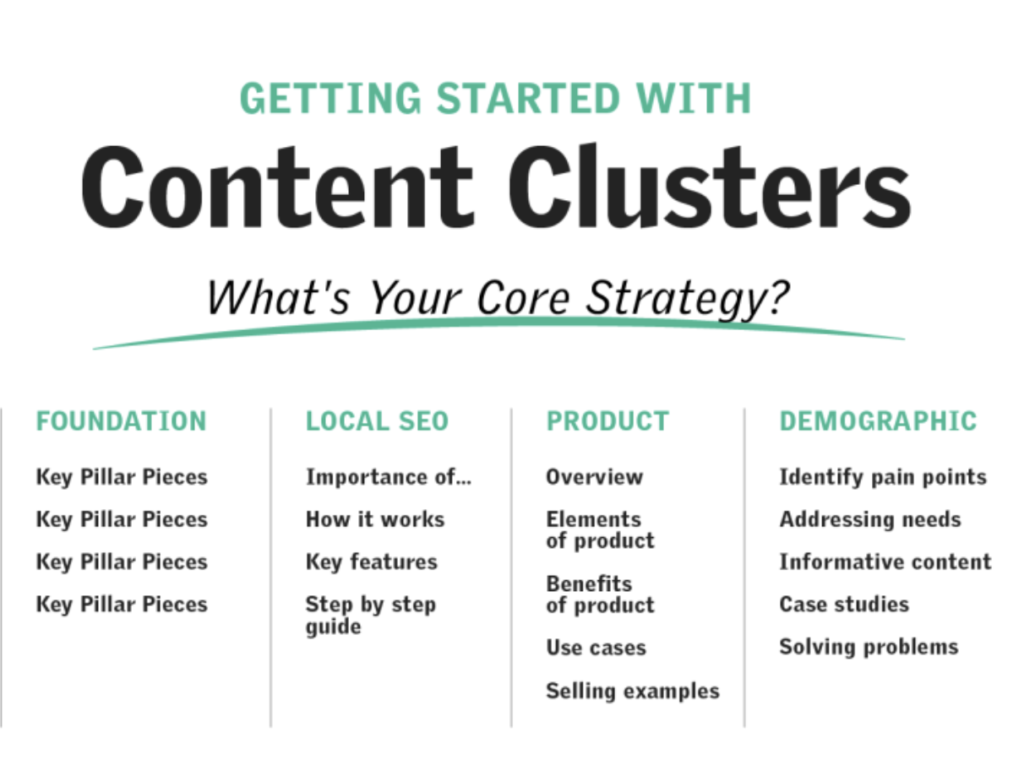Demystifying Content Clusters
What are Content Clusters?
A content cluster strategy is a powerful way to organize and structure your blog or website content. Essentially, a content cluster revolves around a central “pillar” page that covers a broad topic. Supporting this pillar page are multiple “cluster” articles, which delve into specific subtopics related to the main theme. This kind of strategy helps to create a comprehensive coverage of a topic, making your content more valuable and authoritative.
To put it simply, think of a content cluster as a hub-and-spoke model:
- Pillar Page: The hub, offering a general overview.
- Cluster Articles: The spokes, providing detailed insights on specific aspects of the topic.
For more detailed insights on this concept, you can check out the article on what is a content cluster.
Benefits of Implementing Content Cluster Strategy
Implementing a content cluster strategy comes with numerous advantages, particularly for improving search engine optimization (SEO) and enhancing user experience. Here’s a quick rundown of the primary benefits:
| Benefit | Description |
|---|---|
| Improved SEO | By clustering content around a central topic, you can enhance keyword rankings and create a more cohesive internal linking structure. |
| Enhanced User Experience | Users can easily navigate between related articles, finding all the information they need in one place, which increases time spent on your site. |
| Authority Building | Showcasing comprehensive coverage of a topic establishes your site as an authority in your niche, likely resulting in more backlinks. |
For examples of effective content clusters, see our page on content cluster examples.
Another advantage is better content organization. A well-organized cluster strategy makes it easier to keep track of your topics and ensures balanced coverage. For tips on maintaining a structured approach, visit our guide on content cluster organization.
Lastly, a properly executed content cluster strategy can lead to higher conversion rates. When users find your site informative and user-friendly, they are more likely to engage with your services or products.
Implementing a content cluster strategy is a no-brainer if you aim to elevate your SEO game and provide value to your audience.

Mastering Your Content Strategy
When it comes to implementing a content cluster strategy, it’s all about meticulous planning and consistent monitoring. Let me guide you through the crucial steps of this process.
Planning Your Content Cluster
Planning your content cluster begins with identifying a core topic around which all your related content will revolve. This central topic should be broad enough to support multiple subtopics but specific enough to be clearly defined.
- Identify the Core Topic: Think about the primary theme that will be at the heart of your content cluster. Ask yourself: What is the main focus of my blog or website?
- Keyword Research: Conduct thorough keyword research to find relevant subtopics and search terms. Use tools to identify high-volume keywords related to your core topic.
- Content Map: Create a content map to visually organize your cluster. Place your core topic in the center and branch out to include subtopics.
- Internal Linking: Plan your internal links. Each piece of content within the cluster should link back to the core topic and to other related pieces.
| Step | Description |
|---|---|
| Step 1 | Identify the core topic |
| Step 2 | Conduct keyword research |
| Step 3 | Create a content map |
| Step 4 | Plan internal links |
For those interested, detailed tips on content cluster organization can be incredibly useful during this stage.
Executing and Monitoring Your Content Cluster Strategy
Once the planning phase is complete, it’s time to bring your strategy to life.
- Content Creation: Write high-quality content for each subtopic. Each article should provide in-depth information and link to your core topic.
- Internal Linking: Include strategic internal links that connect your subtopics to the main content piece and to each other. This interconnection helps in improving SEO.
- SEO Optimization: Ensure that all pieces are SEO optimized. This includes using relevant keywords, meta descriptions, and alt text for images.
- Publish and Promote: Once everything is set, publish your content and promote it through various channels, such as social media, newsletters, and collaborations.
- Monitor Performance: Use analytics tools to monitor the performance of your content. Keep an eye on metrics like page views, time on page, bounce rate, and keyword rankings.
| Task | Action |
|---|---|
| Task 1 | Content creation for subtopics |
| Task 2 | Strategic internal linking |
| Task 3 | SEO optimization |
| Task 4 | Publish and promote |
| Task 5 | Monitor performance |
Regularly updating and refining your content cluster based on analytic insights helps in maintaining its relevance and effectiveness. For more on optimizing SEO, visit content cluster seo.
By following this structured approach to planning and executing your content cluster strategy, you’ll be able to create a cohesive and impactful network of content that resonates with your audience and performs well in search engines. For further inspiration, check out content cluster examples to see how others have successfully implemented this strategy.

